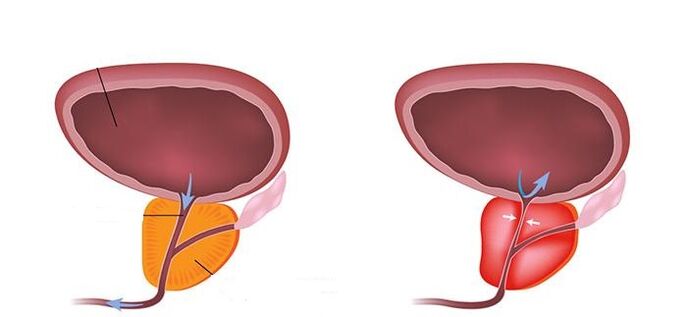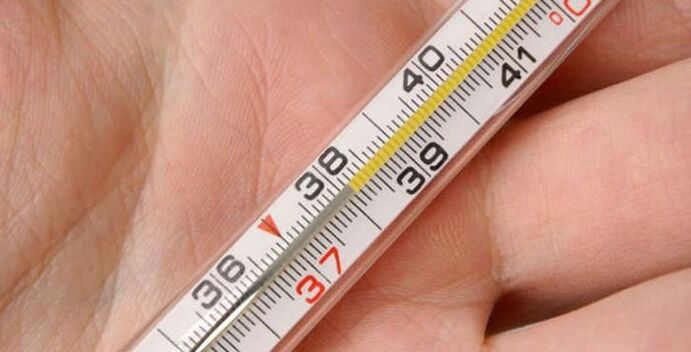According to statistics, every third man of working age suffers from prostatitis at different periods of life. Constant pain, impotence, infertility - this is not a complete list of problems that threaten patients in the absence of treatment. Due to the high urgency and danger of the disease, its symptoms and initial manifestations should be known to every man. In this article you will learn about all the signs and diagnostic methods that allow you to recognize prostatitis.

The clinical picture in the early stages of development
Prostatitis is an inflammatory lesion of the male prostate gland. The following forms of the disease are distinguished: acute and chronic bacterial prostatitis, chronic pelvic pain syndrome, asymptomatic prostatitis. Each form manifests itself in different ways, has characteristic signs and characteristics of the course.
It is difficult to say how the disease will progress in any particular man. The presence of certain symptoms depends on a number of external and internal factors. For convenience in characterizing the pathology, it is common to divide all the symptoms of prostatitis into 3 major groups: those associated with urinary disorders, sexual dysfunction, mental problems. The first and most significant symptoms of prostatitis (except for the asymptomatic form) may be the following signs in men:
- Pain in the pelvis, back, groin.
- Pain and burning during the act of urination.
- Difficulty passing urine.
- Feeling of incomplete emptying of the bladder and false desire to urinate.

Pain in the pelvis, back, groin, feeling of incomplete emptying of the bladder and false desire to urinate are signs of prostatitis.
The listed symptoms are manifested due to impaired urinary function, which is due to the anatomical features of the structure and location of the bladder and prostate gland. The signs of prostatitis associated with sexual dysfunction are also significant and pronounced. Men most often make the following complaints:
- Weak erection.
- Rapid onset of ejaculation during intercourse.
- Lack of orgasm or decreased sensitivity.
- Pain in the urethra and rectum during ejaculation.
Problems with urination and difficulties in intimate life due to inflammation of the prostate gland are of great concern to men. Patients with prostatitis are forced to change their lifestyle, to give up their habits, family relationships become more complicated. Obsession with your problem provokes increased nervousness, anxiety, decreased libido, which can be called indirect signs of prostatitis, belonging to the third group of the above symptoms (mental disorders).

Prostatitis in men can often be confused with prostate adenoma or cancer, a pathology of the bladder. All these diseases appear in a similar way, especially in the initial stages. It is very difficult to distinguish them for an unprepared person, which is why the differential diagnosis is made by analyzing all existing objective symptoms, laboratory and instrumental data from research. As each form of prostatitis has specific signs and characteristics, it is reasonable to consider them separately.
Characteristics of certain forms of the disease
Acute prostatitis is an inflammation of the male prostate gland caused by the penetration of an infectious agent into the body through the blood, lymph or urethra. The disease begins suddenly and is characterized by the severity of all clinical signs. The main symptoms of acute prostatitis:
- The rise in body temperature to 39-40 degrees.
- Symptoms of general intoxication (headache, weakness, fatigue, reduced ability to work, etc. ).
- Severe pain in the perineum, sacrum, above the pubic joint of a man.
- Frequent, painful urination.
- Sometimes men have urinary retention.

A temperature of 39-40 is a clear sign of inflammation of the prostate gland.
Acute inflammation of the prostate gland usually ends with recovery or chronicity of the process (symptoms can be disturbing for several months). But more often this form of prostatitis is the main one and is a consequence of the presence of bad habits (alcohol abuse, smoking, etc. ), sedentary lifestyle, lack of vitamins and minerals, prolonged sexual abstinence or resulting from non -aggressive sexually transmitted infection or ingestion of normal microflora agents. The clinical picture of chronic prostatitis seems more sparse in terms of the acute form, the symptoms of the disease are intermittent, which significantly complicates the diagnosis. For the chronic form of prostatitis, the following symptoms are most typical:
- Increased urge to urinate, including at night.
- Pain in urination and ejaculation.
- Dull pain in the lower back, pelvis, above the armpits, etc.
Chronic pelvic pain syndrome (CPPS) in men combines recurrent prostate pain, temporary disorders of the urinary and reproductive systems. CPPS in medicine is a broader concept, as pathogenetic pathology may be based on a tumor or ischemic process, disorders of the nervous system, and not just inflammation. The discrepancy in the presence of signs of prostatitis in chronic pelvic pain syndrome significantly complicates the diagnosis, but is much more difficult to do in the asymptomatic form. In these cases, the main and decisive role is played by the data from the laboratory and instrumental research methods.
Diagnostic techniques
A definitive diagnosis cannot be made on the basis of prostatitis symptoms alone. In addition, doctors should collect a medical history: clarify information about the time of onset of symptoms, their relationship to major and significant life events, physical and mental shocks, all possible predisposing factors, etc. Always perform a physiological examination - digital rectalexamination in the knee-elbow position of a sick man lying on his side with his legs bent or standing with his body bent forward. During this study, you may find signs characteristic of prostatitis (not all are necessary):
- Enlargement of the male gonad in size.
- The shape of the organ is regular or flattened with depression.
- Clothed or doughy consistency.
- Smoothness of the borders of the prostate gland.
- Increased pain on pressure.

Further examination of a patient with symptoms of prostatitis is supplemented by laboratory methods. General and biochemical blood tests are prescribed - there are no specific changes in the indicators, but only indirect signs that allow to assess the presence of an inflammatory process in the man's body (increase in the number of leukocytes, proteins in the acute phase, accelerated ESR). The results of urine tests will be valuable, which will allow to assess the presence of an infectious process in the genital tract, will help determine the pathogen to initiate etiological treatment. In addition, urologists may prescribe analysis of prostate secretion, spermogram.
Among the instrumental methods for diagnosing prostate diseases, the most informative is TRUS - transrectal ultrasound. In this case, a special sensor is used, which the doctor inserts into the rectum. This causes discomfort to the sick person, but is compensated by the information content of this method. With the help of TRUS it is possible to assess the structure of the organ, to assess the presence of tissue inflammation, the degree of narrowing of the urinary tract and to exclude the presence of stones. The main echo signs of prostatitis: increase in organ size, edema, fibrosis, changes in sclerotic tissue, coarse-grained and heterogeneous structure.
In addition, patients with symptoms of prostatitis undergo uroflowmetry - a special diagnostic procedure that measures the frequency of a man's urination. Based on the data from this study, conclusions can be drawn about the degree of narrowing of the urethra, the activity of the detrusor. Uroflowmetry should not replace TRUS, but rather confirm its findings and signs of existing prostatitis.
The diagnostic test plan for prostatitis may be extended if indicated in a man. To clarify individual points regarding the diagnosis can be performed cystoscopy, CT scan of the pelvis. In unclear cases, a biopsy is performed for differentiation with tumor processes.
What to do when the first symptoms appear
The biggest and most common mistake that many men make when they have signs and symptoms of prostatitis is waiting. Each patient hopes that the unpleasant symptoms are temporary and will soon disappear. Untreated prostatitis is dangerous to health, leading to irreversible changes in the body, which are fraught with impaired erection, infertility or worse - a malignant disease of the process (transition to cancer).
To prevent serious complications, every man at the first signs of prostatitis should consult a urologist, who will prescribe treatment. First of all, men are given etiotropic therapy - anti-inflammatory drugs, antibiotics are used, measures are taken to strengthen the immune system. There is no need for surgery in the absence of complications. Men who have had prostatitis in the past are at risk and are more likely to relapse, which is why prevention is given a big role after recovery.



























